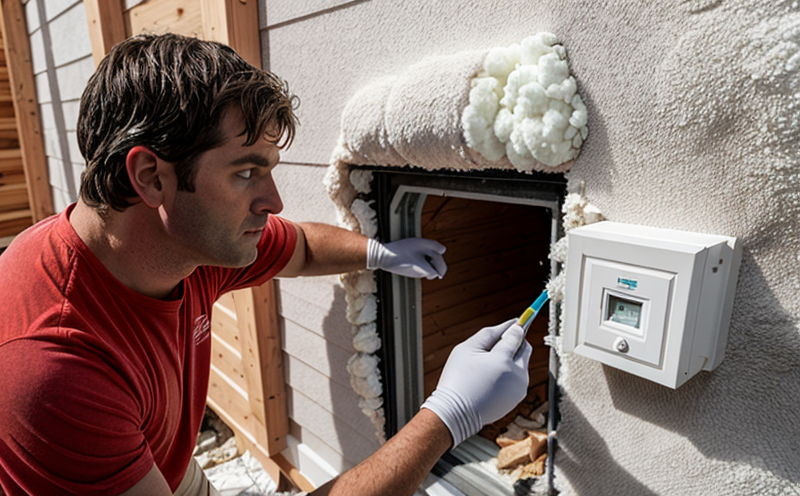ISO 8990 Heat Flow Through Insulating Materials
The ISO 8990 standard is a cornerstone in the assessment of heat flow through insulating materials. This test measures the thermal resistance, or R-value, of building insulation and other similar materials under controlled conditions. Understanding the thermal performance of insulations is crucial for ensuring energy-efficient buildings.
This test is particularly relevant for the construction sector where the focus is on reducing heating and cooling costs while maintaining occupant comfort. The standard applies to a wide range of insulating materials such as foams, fibers, and boards used in walls, roofs, floors, and other building elements.
The test setup involves a specimen placed between two plates at different temperatures. A steady state condition is achieved when the heat flow through the material remains constant over time. The heat flux sensor measures this heat flow while the temperature difference across the insulation is maintained by controlled heating and cooling systems.
Accurate measurement of thermal resistance using ISO 8990 helps architects, engineers, and builders make informed decisions about the choice of insulating materials for their projects. This ensures that the materials perform optimally in real-world conditions, which can significantly reduce operational costs and contribute to a greener building envelope.
The standard is widely recognized and accepted globally, making it an essential tool for compliance with local building codes and standards. By adhering to ISO 8990, organizations ensure that their products meet the highest industry standards for thermal performance.
- Materials tested: Foams (polyurethane, polyethylene), fibers (glass wool, mineral wool), boards (fiberglass, expanded polystyrene).
- Applications: Walls, roofs, floors, attics, basements.
The test results are used to determine the thermal resistance of insulating materials, which is a critical parameter in energy-efficient design. The R-value provides insights into how well the material resists heat transfer, thereby helping to reduce heating and cooling loads on buildings.
Understanding the thermal properties of insulation is crucial for various stakeholders involved in building construction. Quality managers can use these results to ensure product quality compliance, while R&D engineers can leverage them to innovate new materials or improve existing ones. Compliance officers will find this test essential for verifying that products meet regulatory requirements and industry standards.
The ISO 8990 standard is also beneficial for procurement teams as it allows for the comparison of different insulation options based on their thermal performance. This ensures that the most suitable material is chosen, balancing cost-effectiveness with energy efficiency and durability.
Benefits
The implementation of ISO 8990 Heat Flow Through Insulating Materials offers numerous benefits across various sectors:
- Energy Efficiency: Ensures that insulating materials perform optimally, leading to reduced heating and cooling costs.
- Sustainability: Promotes the use of sustainable insulation options that contribute to a greener building envelope.
- Regulatory Compliance: Helps organizations meet local building codes and standards by ensuring product compliance.
- Innovation: Facilitates the development of new materials with enhanced thermal properties.
The test also supports quality assurance and control processes, helping to maintain consistent performance across different batches or suppliers. This ensures that products meet the required specifications and deliver the expected thermal resistance in real-world applications.
By using ISO 8990 Heat Flow Through Insulating Materials testing, organizations can enhance their reputation for delivering high-quality, energy-efficient solutions. The test results provide valuable data that inform decision-making processes across various stages of project development.
Why Choose This Test
The ISO 8990 Heat Flow Through Insulating Materials test is a preferred choice for several reasons:
- Achieves Steady-State Conditions: The standard ensures that the heat flow through the material remains constant over time, providing reliable and consistent results.
- Global Recognition: As an ISO standard, it enjoys widespread acceptance and is recognized globally, ensuring that test results are universally applicable.
- Comprehensive Data: The test provides comprehensive data on thermal resistance, which is crucial for making informed decisions about insulation materials.
- Regulatory Compliance: Ensures that products meet stringent regulatory requirements and industry standards.
The test is also advantageous because it allows for the comparison of different insulation options based on their thermal performance. This ensures that the most suitable material is chosen, balancing cost-effectiveness with energy efficiency and durability. Furthermore, the use of this standard supports quality assurance and control processes, helping to maintain consistent performance across different batches or suppliers.
The results from ISO 8990 Heat Flow Through Insulating Materials testing provide valuable data that inform decision-making processes across various stages of project development. This ensures that products meet the required specifications and deliver the expected thermal resistance in real-world applications.
Competitive Advantage and Market Impact
The adoption of ISO 8990 Heat Flow Through Insulating Materials test provides significant competitive advantages:
- Enhanced Product Quality: By ensuring that products meet the highest industry standards for thermal performance, organizations can differentiate themselves in a crowded market.
- Cost Savings: The use of this standard helps to reduce heating and cooling costs, leading to substantial cost savings over time.
- Sustainability Leadership: Promoting sustainable practices by using high-quality insulation materials that contribute to greener buildings can enhance an organization's reputation as a leader in sustainability.
The test also supports regulatory compliance, ensuring that products meet stringent requirements and industry standards. This not only reduces the risk of non-compliance but also helps organizations stay ahead of evolving regulations.
Furthermore, by providing comprehensive data on thermal resistance, ISO 8990 Heat Flow Through Insulating Materials testing enables informed decision-making processes across various stages of project development. This ensures that products meet the required specifications and deliver the expected thermal resistance in real-world applications, thus enhancing their marketability and competitive positioning.
The use of this standard also supports quality assurance and control processes, helping to maintain consistent performance across different batches or suppliers. This ensures that products meet the required specifications and deliver the expected thermal resistance in real-world applications. The test results provide valuable data that inform decision-making processes across various stages of project development.





